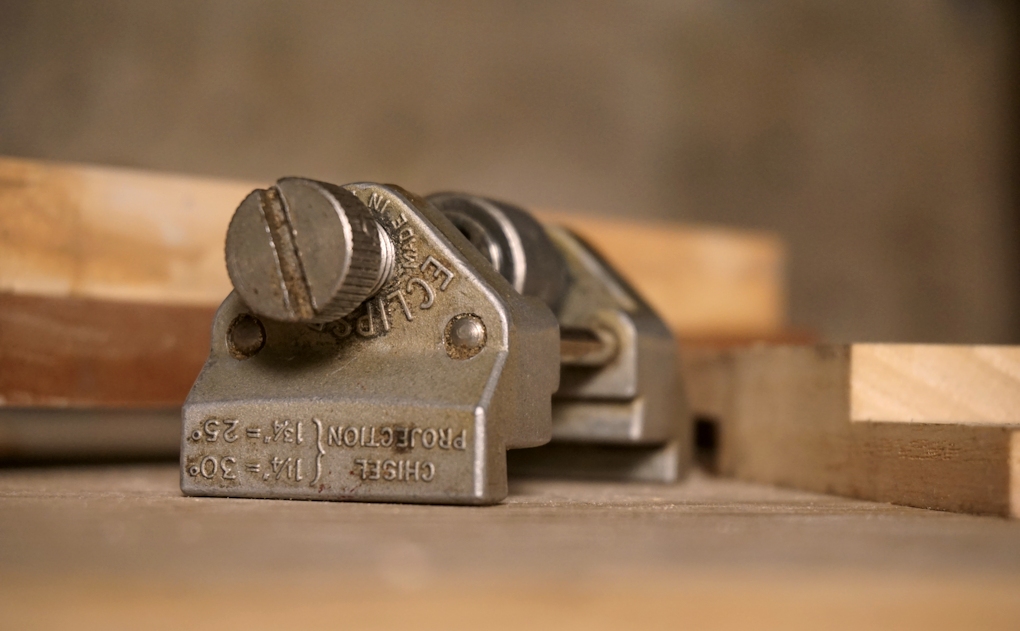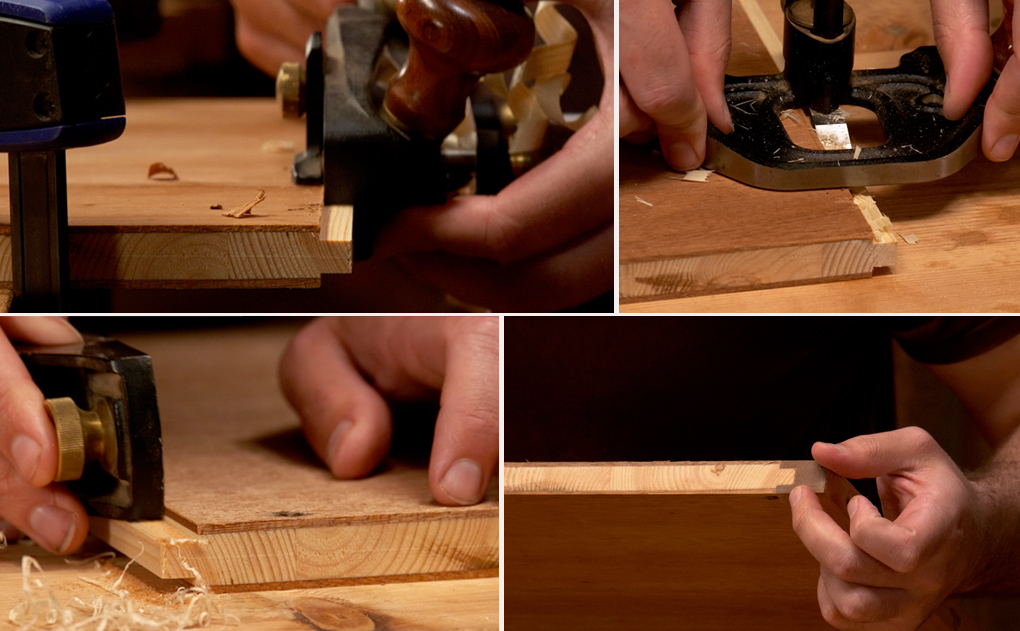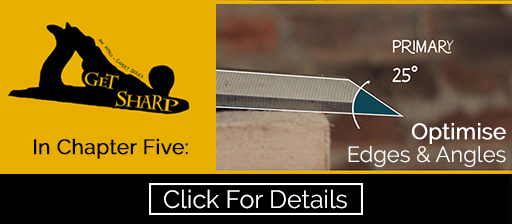
We all need sharp tools. Sharpening is an odd subject because if you can’t do it, it seems mysterious. And if you can do it, some become so loyal to their method that they would fight to the death to defend it. Often trying no other method
As you may know I have my own strong opinions on sharpening but I have to stay open minded. I recently dug out a little Eclipse guide for Helen and made her a jig so she can align the blade exactly every time. I’ve never sharpened like this but I think it makes an awful lot of sense for the beginner. Straight away Helen was able to achieve results that were on par with mine (if not better), this demonstrates the wonderful thing about having little testosterone and therefore being comfortable in accepting assistance.
Along with helping Helen learn the ropes I’ve been doing a bit of experimenting of my own. I got my hand on a water stone a few months back and recently decided that I would trial some of the more popular techniques for sharpening, and who knows I might even learn something new.
For the coming weeks I’ll be on a water stone with a sharpening guide, something which I’ve never done in my life. I’m spending what feels like an eternity at the stone compared with my usual spit and flick, but can already appreciate the longer lasting edge that results. I am feeling strangely excited about this change.
Why am I doing this? I haven’t got a clue!
Read more of my hypocritical thoughts on sharpening.

![Which Saws Are Best For Ripping Thick Stuff? [Video]](https://www.theenglishwoodworker.com/wp-content/uploads/2022/12/what-hand-saw-is-best-for-thick-rip-cuts.jpg)
![How do I Sharpen a Router Plane? [Q & A Video]](https://www.theenglishwoodworker.com/wp-content/uploads/2022/11/how-to-sharpen-a-router-plane-video.jpg)
![Bench Top Edge Jointing [with Video]](https://www.theenglishwoodworker.com/wp-content/uploads/2022/10/bench-top-edge-jointing-video.jpg)


Nice example of “whatever works”. Some things really need freehand. Many can go freehand, guide, or machine. Same for stone type. Oilstone, sandpaper, diamond plate, waterstone, lapping compound on cast iron or granite, whatever gets the job done. My go to is freehand for dressing and edge. Machine or guide (or both) for major rework. Usually use sandpaper for roughing, and emery, fine stone, lapping compound, whatever, for finishing, depending on the desired finish to the edge and the configuration of the edge. I have some nice bronze rounds that I use with valve lapping compound to finish gouges, for example, and leather belting that gets used with rouge or green compound for stropping tools that need it.
Thanks, yep I’m normally just an oil stone and spit man for pretty much everything but if I need a superior edge then I just strop with a bit of compound. It’s a lovely thing with this blog, that it’s an excuse for me to experiment.
I slop it on an oil stone and then strop with compound.. 15 seconds and I’m splitting atoms.
This is not the way I was taught 20 years ago… 😉
I try and keep my mind open to choices in most aspects of my life, woodworking included. I don’t ever change something I do, just for the sake of changing it, but if someone presents an idea to me that has legitimate merit, I’m happy to give it an honest go and see which way I like better.
I think most of this comes from where I used to sit in my old position (same company). I was seated right outside the office of the VP of our department. He was a great guy, very genial and smart and fun to be around. He had one pet peeve, though, and that was when a programmer or developer would counter a suggestion of his for change with, “Well, this is the way we’ve always done it!”
It was like standing 5′ from a freight train when he exploded at them. I was never on the receiving end of one of those rants; just close enough to know I never wanted to be.
“I’ve tried five different ways and I still get the best results with my old way.” – this is a legitimate excuse.
“Because that’s the way I’ve always done it.” – this is not.
Great summation.
Thanks Ethan for another wonderful comment. Your quotes sum things up very well.
This could be the sort of thing you’re looking for, with ‘cut outs’ to get exactly the right angle every time with either the Rider or Eclipse gauge. I’m going to be shooting an Ax video about this in a couple of weeks:
http://www.axminster.co.uk/axminster-rider-sharpening-station-kit
Looks interesting Rob, it should probably do quite well. The jig I made for Helen, as you’ve probably guessed is a stick with a notch cut in it.
I’ve found the eclipse guide to be very helpful, as my muscle memory is not as good as it used to be. While I’ve used inexpensive diamond plates and oilstones, and gotten good results, I’ve recently gotten a Workshop 3000 machine and am amazed at how good an edge it has produced on a variety of plane blades. Really no skill needed, and it’s very fast. Resulting edge has been working really well in the plane on the wood.
I had also been messing with a Delta sharpening station with a waterbath large, slow stone, and a slow speed 6″ stone, with a Veritas jig, and found it very troublesome to consistently hit the bevel angle with accuracy. It’s going in the yard sale next week!
Thanks Marc, most of the battle with grinding machines is being able to hold the blade accurately. Luckily for myself my usual sharpening method very rarely requires any grinding, I hope that Delta station goes down well at the boot sale!
Nothing wrong with using a honing guide – I use one all the time. Overall, the Eclipse type is best in my view and the narrow wheel makes it easy to get the degree of camber that you want, or no camber if that is appropriate. Simply adjust your finger pressure on the edge of the blade as necessary.
Cheers Paul, that’s something I’ve been massively surprised about – how good the guide is for camber control. My stupid brain told me that these things would only sharpen square!
I have improved my hand sharpening skills considerable in recent years; however when restoring of first setting up an edge I still use the Veritas guide. I find no denuding of my assets on the days I sharpen w/ a guide; I think my testosterone levels are holding up nicely – have to check with my wife. Kudos to you Richard for taking a risk.
Thanks Jim, I’ve been very surprised at how well these guides work and I can certainly see that they’d come in for restoring, whatever the testosterone levels.
I started with that guide. It is a good way to start, let you hit the ground running for sure.
I don’t use it much for most of my tools now, however, it is perfect for my bevel up planes. Normal tools can have some variation in the angle without really causing issue. But I have found being able to hit an exact angle with the jig is very desirable with bevel up planes. It the only way I can guarantee a repeatable exact angle time after time.
Hi Bill, that’s a very good point with the bevel up, they’re about the only tools I’ve found to really pay to know what your angle is. It’s so surprising how something so simple can allow someone who’s never been able to obtain an edge, to obtain an edge that’s as good as the next man’s.
I fear you may have opened a can of worms Richard! This could end up the longest set of responses you have ever seen. 😉
I was taught freehand honing at school, back in the early ‘sixties, together with taking the bur off by slapping it in the hand. When I returned to woodworking in the ‘eighties, as an occasional hobby, I bought an Eclipse honing guide after finding I had lost my touch for doing it freehand. I used that for years, getting a consistent slant across the edge of every iron or chisel, until I realised I could simply file the aluminium to correct the error and get a square cut.
Recently, after having to hone more and more knives, curved blades, gouges, moulding planes etc. I’ve returned to freehand honing. It’s so much quicker, and no second bevel or micro bevel to worry about.
I’ll not argue about oilstones/waterstones/diamond plates – they all work at different speeds. Use what you’ve got, I say. The more you do it the better you get at it. Same as most things.
Thanks Ian, I know exactly what you mean about the speed. I can get a working edge on a chisel in under ten seconds free hand, with the guide it’s coming in at nearly three minutes. But then again sometimes it’s nice to have a breather and gain your thoughts.
As for the can of worms, I open one of them every day!
Online video instruction is one of the greatest things that ever happened in woodworking. When I started out, I followed one of the Krenov books but was only occasionally happy with the results and was never certain that I was interpreting the instructions correctly, so I put off re-sharpening for far too long. An eclipse guide helped but showed me that my stones were dished. I looked around for stone flattening plates and came across Paul Seller’s video. I never looked back; I sharpened every edge in my kit and found I was able to tune my planes to a much better standard than before. It just helped everything. I’ll die a freehand/convex-bevel man.
Loving the renewed blog activity and looking forward to the premium stuff.
Mostly it’s the simplest solutions that work best. Still, I get dismayed when someone preaches that hand-honing is the only ‘right’ way. As with most aspects of our craft, it’s ‘whatever pleases you’ (As Frank Klausz might say.) To do good woodwork you MUST have sharp tools. How you arrive at this happy state is as personal to you, as the work you do. I am a ‘freehand, little and often’ sharpener; but if someone else prefers a guide, no problemo!
Well done Helen!
With suitable stones and and an Eclipse type guide, you will get the best edge available for most tools.
(Wide rollers work for some tricky skews).
Blade back preparation is crucial. A fact which we discover on most of my tool tuning courses!
best wishes,
David
The only problem with an Eclipse guide and a water stone, is the hollow which the wheel rapidly ploughs into the stone. It takes much less time than it does with an oilstone. I got around this by keeping the roller on a piece of hardwood, the same thickness as the stone. A piece of slate would be better, but it’s thicknessing the stuff! 🙂
Cheers
John
This honing guide (resp. the no-name copy of it) was a big relief for me. I’m all new to woodworking and sharpening was a major problem in the beginning. With this guide, two wood blocks for angle setting and a set of waterstones, I can shave my arm in less than a minute. I hope that’s sharp enough. This let’s me focus on (learning) the woodworking part. 🙂
I also use Naniwa sharpening stones which are from the harder variety. Together with a micro bevel this limits wear on the waterstones since it takes only a few strokes to get a sharp edge. So flattening is not a big issue. (Let alone that I work only a few hours a week….) They also don’t need soaking. A quick spray of water from a spray bottle is sufficient to hone away.
So I guess, there are as many sharpening techniques out there as are woodworkers. Was it necessary to share mine? Maybe not. But this setup Works For Me™. It’s simple, fast and reproducible. (I think there is a lot of overthinking going on in the sharpening world.) May it help another newbie to find her/his own way. (Or confuse the hell out of them.)
Regards
Meikel, the chap who can only cut on lines not next to them…